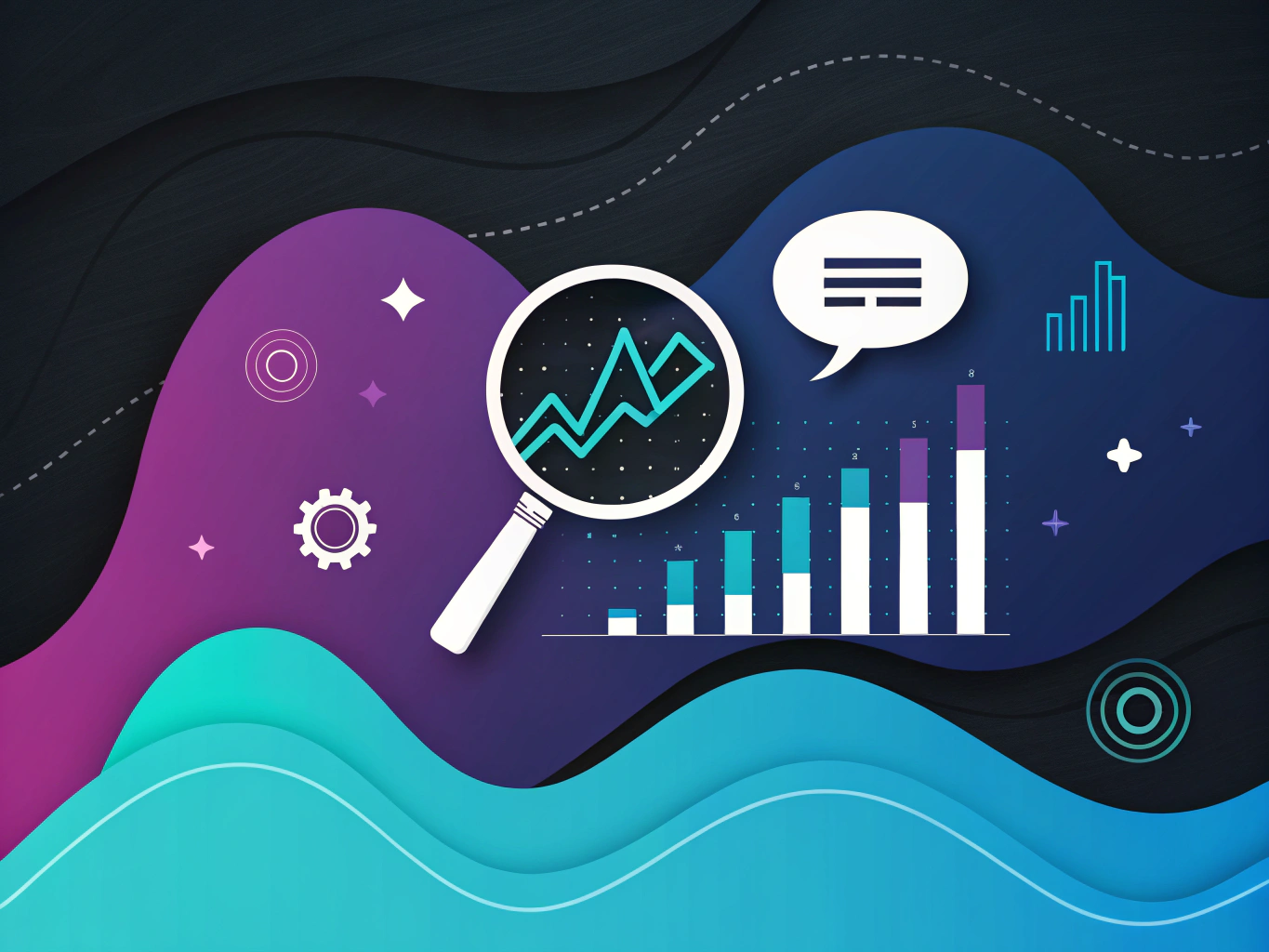The Evolution of Understanding Customer Emotions Through AI
Remember when figuring out if customers liked your product meant reading through endless feedback forms and trying to guess what a 3-star review really meant? Those days feel like ancient history now that we’ve got sentiment analysis NLP in our toolkit. But here’s the thing – while everyone’s talking about how AI can read emotions, there’s still a massive gap between the hype and what these systems can actually do.

I’ve spent years working with brands trying to decode customer feelings, and I’ll tell you this: sentiment analysis is like having a really observant friend who’s great at reading the room, but sometimes misses subtle jokes. It’s powerful, but it’s not magic.
Understanding Sentiment Analysis NLP: Beyond the Buzzwords

At its core, sentiment analysis NLP is teaching computers to understand human emotions in text. Think of it as giving AI emotional intelligence training – except instead of learning through life experience like humans do, it learns through processing millions of labeled examples of emotional expression.
The ‘NLP’ part (natural language processing) is what makes this whole thing work. It’s the difference between a computer seeing “This product is the bomb!” and knowing whether that’s a good thing or if someone’s actually complaining. And trust me, that distinction matters a lot when you’re trying to figure out what customers really think about your latest product launch.
The Four Pillars of Sentiment Analysis
Here’s where it gets interesting (and where most articles get it wrong). There are four main steps to how sentiment analysis actually works:
- Text Detection and Preprocessing: Cleaning up the mess of human language into something a computer can work with
- Feature Extraction: Identifying the parts of text that actually matter for determining sentiment
- Classification: Making the actual decision about whether something is positive, negative, or neutral
- Aggregation: Pulling all these individual insights together into something actually useful
Real-time Sentiment Analysis: When Every Second Counts
You know what’s wild? We’ve gone from taking weeks to understand customer sentiment to doing it in real-time. This isn’t just some cool tech feat – it’s changing how brands interact with their customers fundamentally.
I was working with an ecommerce brand last month that started using real-time sentiment analysis on their customer service chat. They caught a potential PR crisis brewing when their sentiment analysis tool flagged a spike in negative emotions around a new product launch. The issue? A small but significant packaging problem that was frustrating customers. They fixed it before it became a Twitter storm.
The Deep Learning Revolution in Sentiment Analysis
Here’s where things get really interesting (and slightly sci-fi). Modern sentiment analysis techniques aren’t just looking at words anymore – they’re understanding context in ways that would’ve seemed impossible just a few years ago. We’re talking about systems that can pick up on sarcasm, understand cultural references, and even factor in the subtle ways different demographics express emotions online.
The AWS sentiment analysis tools, for instance, can now detect subtle variations in emotional expression across different market segments. It’s not perfect (nothing is), but it’s getting eerily good at understanding the emotional subtext of customer communications.
Beyond Basic Positive/Negative Classification
Remember when sentiment analysis was just about sorting things into “good” and “bad” buckets? Those days are long gone. Modern sentiment analysis techniques can identify complex emotional states like frustration, confusion, excitement, or hesitation. This isn’t just about knowing if customers are happy – it’s about understanding the full emotional journey they’re on with your brand.
And here’s the kicker: the best sentiment analysis systems now can track how emotions change over time. They can spot when initial excitement about a product turns to frustration, or when customer service interactions go from tense to satisfied. This temporal aspect of sentiment analysis is something I rarely see discussed, but it’s absolutely crucial for brands trying to understand their customer relationships.
The Human Element in AI Sentiment Analysis
Let’s be real for a second – AI sentiment analysis isn’t replacing human intuition; it’s enhancing it. I’ve seen too many brands get caught up in the numbers and forget that behind every sentiment score is a real person with real emotions. The best implementations of sentiment analysis are the ones that use AI to scale human empathy, not replace it.
Think of sentiment analysis as your emotional radar system. It can alert you to changes in customer sentiment, but you still need human intelligence to understand the why behind those changes and figure out what to do about them.
Core Techniques in Sentiment Analysis: Where the Magic (and Math) Happens

Let’s get real about sentiment analysis for a minute. While everyone’s talking about how AI can magically understand human emotions, the truth is a bit more… mechanical. Think of it like teaching a robot to understand sarcasm – it’s not impossible, but it requires some serious engineering gymnastics.
The Three Musketeers of Sentiment Analysis
There are three main approaches to sentiment analysis, each with its own quirks and superpowers. Kind of like choosing between Iron Man’s suit, Thor’s hammer, or Doctor Strange’s magic – they all get the job done, just… differently.
1. Lexicon-Based Analysis: The OG Approach
Remember those old-school dictionaries your parents kept around? Lexicon-based analysis is kind of like that, but for emotions. It works by maintaining massive databases of words and their emotional scores. “Amazing” might get a +3, while “terrible” gets a -3. Simple, right?
But here’s where it gets interesting: modern lexicon approaches like VADER (and no, not that Vader) can actually handle emojis, slang, and even punctuation!!!!! (See what I did there? Those exclamation marks would actually boost the sentiment score.)
2. Machine Learning Methods: Teaching Computers to Feel
This is where things start getting spicy. Machine learning approaches don’t just look up words in an emotional dictionary – they learn patterns from massive amounts of labeled data. It’s like having an intern read millions of customer reviews and gradually learning what makes people happy or angry.
The cool thing about ML methods is they can pick up on subtle patterns humans might miss. A Naive Bayes classifier (fancy name, I know) might notice that people who use “but” in their reviews often end up giving negative ratings, even if the first half was positive.
3. Deep Learning: The New Kid on the Block
If machine learning is like teaching an intern to understand emotions, deep learning is like giving that intern a brain upgrade. These neural networks can understand context in ways that make earlier approaches look primitive.
Take BERT (no, not Ernie’s friend) – it can understand that “killing it” in “your product is killing it” is actually positive, while “killing it” in “your buggy checkout process is killing it” is negative. Context is everything, folks.
Advanced Sentiment Analysis: Beyond “Good” and “Bad”
Here’s where sentiment analysis gets really interesting for ecommerce brands. It’s not just about whether customers love or hate your product – it’s about understanding the why, when, and how of their emotions.
Aspect-Based Sentiment Analysis
Think of this as emotional dissection. Instead of just knowing a customer gave your product 2 stars, you can understand that they loved the design (+5), thought the price was okay (+1), but hated the shipping time (-4). This granular understanding is pure gold for product teams.
Real-Time Sentiment Analysis
Remember the last time a tweet about your brand went viral? Real-time sentiment analysis is like having an emotional early warning system. It can detect sentiment shifts as they happen, letting you respond to issues before they become crises.
At ProductScope AI, we’ve seen brands transform their customer service by implementing real-time sentiment tracking. One fashion retailer caught a sizing issue within hours of a product launch, potentially saving thousands in returns and customer service headaches.
The Human Element: Why Pure AI Isn’t Enough
Here’s the thing about sentiment analysis that most tech blogs won’t tell you: it’s not perfect. AI can still get confused by complex human emotions, cultural nuances, and that most devilish of all human traits – sarcasm.
That’s why the most successful implementations combine AI’s processing power with human insight. Think of sentiment analysis as a really smart assistant – it can do the heavy lifting of processing thousands of comments, but you still need human judgment for the final call.
Practical Applications in Ecommerce
Let’s get practical. How are real brands using sentiment analysis? Here’s where the rubber meets the road:
- Product Development: Understanding emotional responses to features before full launches
- Customer Service: Prioritizing responses based on sentiment severity
- Marketing: Testing campaign messages against historical sentiment data
- Competitive Analysis: Tracking sentiment around competitor products and launches
The Future of Sentiment Analysis
We’re entering an era where sentiment analysis is becoming more nuanced and powerful. The latest models can detect emotions like confusion, frustration, and even buying intent. For ecommerce brands, this means moving beyond simple positive/negative classifications to understanding the full spectrum of customer emotions.
But here’s the kicker – as these tools become more sophisticated, the key differentiator won’t be the technology itself, but how creatively and ethically brands use it. It’s not about having the most advanced sentiment analysis tool; it’s about using it to create genuinely better customer experiences.
Real-Time Sentiment Analysis: The Future of Customer Understanding
Look, we’ve all been there. You’re scrolling through hundreds of customer reviews, trying to figure out if people actually like your new product launch or if they’re just being polite. Traditional analytics tell you the conversion rates, but they don’t tell you how people feel.
This is where real-time sentiment analysis becomes your secret weapon. It’s like having an emotional radar that continuously scans customer interactions, giving you instant insights into the collective mood of your audience. But here’s the thing – it’s not just about positive or negative anymore.
Beyond Binary: The Evolution of Sentiment Scoring
Remember when we thought a simple thumbs up or down was enough? Those days are gone. Modern sentiment analysis techniques use sophisticated scoring systems that can detect nuanced emotions like frustration, excitement, or even sarcasm (yeah, AI is finally getting better at understanding when your customers are throwing shade).
AWS sentiment analysis and other cloud platforms have made these tools accessible to businesses of all sizes. But here’s what most people get wrong – they treat sentiment analysis like a set-it-and-forget-it tool. It’s not. It’s more like a living, breathing system that needs to be trained and refined based on your specific customer base.
The Four Pillars of Modern Sentiment Analysis
 how do natural language processors determine the emotion of a text?“/>
how do natural language processors determine the emotion of a text?“/>Let’s break down what makes sentiment analysis in deep learning actually work in practice:
- Contextual Understanding: The system needs to know that “sick” means different things in a skateboarding forum versus a healthcare discussion
- Emotional Granularity: Moving beyond positive/negative to understand specific emotional states
- Real-Time Processing: Because customer sentiment can shift faster than a TikTok trend
- Action-Oriented Insights: Converting emotional data into actionable business decisions
The Marketing Revolution: Sentiment-Driven Strategies
Here’s something wild – sentiment analysis marketing isn’t just about damage control anymore. Smart brands are using it to predict trends before they explode. Think of it as emotional time travel – you’re catching the wave of customer sentiment before it hits the shore.
I recently worked with a DTC brand that completely revamped their product roadmap based on sentiment analysis of customer support tickets. They discovered that their customers weren’t just buying their sustainable packaging products – they were emotionally invested in the entire eco-friendly lifestyle. This led to a whole new product line that doubled their revenue in six months.
Natural Language Processing: The Engine Behind Emotional Intelligence
How do natural language processors determine the emotion of a text? It’s not magic (though sometimes it feels like it). Modern NLP sentiment analysis combines linguistic rules with machine learning in a way that’s surprisingly similar to how humans process language.
But here’s what makes it powerful – it can do this at scale, processing millions of conversations simultaneously. It’s like having a million customer service reps, each with perfect emotional intelligence, working 24/7.
The Future is Already Here
Remember those sci-fi movies where computers could understand human emotions? We’re basically living in that future now. The method of sentiment analysis has evolved to the point where it can detect emotional patterns that even humans might miss.
The purpose of sentiment analysis isn’t just to gather data – it’s to build genuine connections with your customers. When you understand not just what they’re saying, but how they’re feeling, you can create experiences that resonate on a deeper level.
Practical Applications for Your Business
Let’s get real for a moment. Here are some sentiment analysis examples that you can implement today:
- Monitor social media mentions in real-time to catch potential PR issues before they blow up
- Analyze customer service interactions to identify emotional triggers that lead to churn
- Track sentiment across different customer segments to personalize marketing messages
- Use sentiment scores to prioritize product feature requests based on emotional intensity
The Human Element
Here’s the thing though – and this is important – sentiment analysis should augment human understanding, not replace it. Think of it as an emotional metal detector. It can point you to where the valuable insights are buried, but you still need human intuition to understand the full context.
The most successful implementations I’ve seen are where brands use sentiment analysis as a starting point for deeper customer conversations, not as the final word on customer feelings.
Looking Forward: The Evolution of Customer Understanding
As we wrap up this deep dive into sentiment analysis, remember this: the technology will keep evolving, but the fundamental goal remains the same – understanding and connecting with your customers on a human level.
The brands that will win in the next decade aren’t just the ones with the best algorithms – they’re the ones who use these tools to build genuine emotional connections with their customers. Because at the end of the day, business is still about people understanding people. We’re just getting better tools to help us do it.
Related Articles:
- Sentiment Analysis Python: Build a Powerful NLP Model
- Sentiment Analysis Tools: A Beginner’s Guide to Success
- Sentiment Analysis Secrets for Marketing Success – ProductScope AI
Frequently Asked Questions
What is NLP sentiment analysis?
NLP sentiment analysis is a technique used in natural language processing to determine the emotional tone behind a body of text. It involves analyzing and categorizing opinions expressed in a piece of text, which can range from reviews and social media posts to entire articles, to gauge whether the overall sentiment is positive, negative, or neutral.
What are the four main steps of sentiment analysis?
The four main steps of sentiment analysis typically include data collection, data preprocessing, sentiment detection, and sentiment classification. Data collection involves gathering text data from various sources, while preprocessing cleans and prepares the data for analysis. Sentiment detection identifies whether the text contains subjective information, and sentiment classification assigns a sentiment score or category to the text.
What is sentiment analysis in deep learning?
Sentiment analysis in deep learning leverages advanced neural network architectures, such as recurrent neural networks (RNNs) or transformers, to analyze text data more effectively. These models can capture complex patterns and contextual nuances in language, resulting in more accurate predictions of sentiment compared to traditional machine learning approaches.
What is the method of sentiment analysis?
The method of sentiment analysis involves using algorithms to detect and interpret the emotional tone of textual data. This can be achieved through rule-based systems, machine learning models, or deep learning techniques, which analyze the language used in the text to classify the sentiment as positive, negative, or neutral.
What is the purpose of sentiment analysis?
The purpose of sentiment analysis is to help businesses and organizations understand the opinions and emotions of their customers or the public towards their products, services, or brand. By analyzing sentiment, companies can gain valuable insights into consumer attitudes, improve customer service, monitor their brand reputation, and make informed decisions based on public perception.
About the Author
Vijay Jacob is the founder and chief contributing writer for ProductScope AI focused on storytelling in AI and tech. You can follow him on X and LinkedIn, and ProductScope AI on X and on LinkedIn.
We’re also building a powerful AI Studio for Brands & Creators to sell smarter and faster with AI. With PS Studio you can generate AI Images, AI Videos, Blog Post Generator and Automate repeat writing with AI Agents that can produce content in your voice and tone all in one place. If you sell on Amazon you can even optimize your Amazon Product Listings or get unique customer insights with PS Optimize.
🎁 Limited time Bonus: I put together an exclusive welcome gift called the “Formula,” which includes all of my free checklists (from SEO to Image Design to content creation at scale), including the top AI agents, and ways to scale your brand & content strategy today. Sign up free to get 200 PS Studio credits on us, and as a bonus, you will receive the “formula” via email as a thank you for your time.




